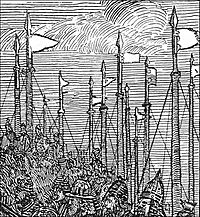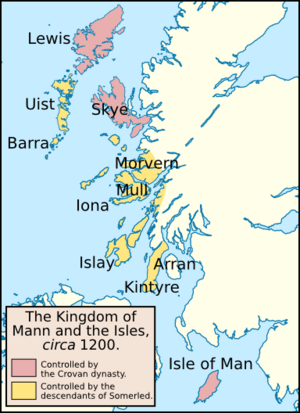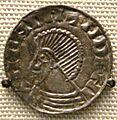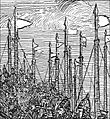Kingdom of the Isles facts for kids
Quick facts for kids
Kingdom of Mann and the Isles
Suðreyjar (Old Norse)
|
|||||||||||||||||
|---|---|---|---|---|---|---|---|---|---|---|---|---|---|---|---|---|---|
|
|||||||||||||||||
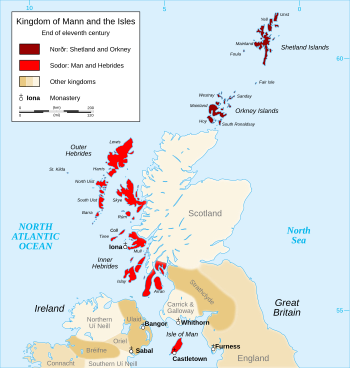
Kingdom of the Isles or 'Sodor' (bright red) in the 11th Century
|
|||||||||||||||||
| Status | Kingdom under Norwegian suzerainty | ||||||||||||||||
| Common languages |
|
||||||||||||||||
| Religion |
|
||||||||||||||||
| History | |||||||||||||||||
|
• Formed
|
849 | ||||||||||||||||
|
• Vassalised, then absorbed into the Kingdom of Scotland
|
1265 | ||||||||||||||||
| Currency | Penny | ||||||||||||||||
|
|||||||||||||||||
| Today part of | |||||||||||||||||
The Kingdom of the Isles was a powerful kingdom that existed from the 800s to the 1200s AD. It was made up of the Isle of Man, the Hebrides (a group of islands off Scotland), and the islands in the Firth of Clyde. The Norsemen (Vikings) called these islands the Suðreyjar, meaning "Southern Isles." This was to tell them apart from the "Northern Isles" like Orkney and Shetland.
Sometimes, this kingdom is also called the Kingdom of Mann and the Isles. The history of this kingdom is a bit tricky because records are incomplete. Its rulers were sometimes independent, but often they were under the control of Norway, Ireland, England, Scotland, or Orkney. The islands cover a huge area, stretching over 500 kilometers (about 310 miles) from north to south.
Viking influence in this area started in the late 700s. A powerful family called the Uí Ímair played a big role early on. There were often fights between the Kings of the Isles and the rulers of Ireland. Norway also frequently got involved, either directly or through their local leaders in Orkney.
Around the late 1000s, Magnus Barefoot of Norway invaded, leading to a short time of direct Norwegian rule. But soon, the family of Godred Crovan took back control. This independent rule ended when Somerled rose to power. After his death in 1164, the kingdom split into two parts. About a century later, in 1266, the islands became part of the Kingdom of Scotland after the Treaty of Perth.
Contents
Where Was This Kingdom?
The main islands that were part of the Kingdom of the Isles include:
- The Isle of Man: This island is in the middle of the Irish Sea, roughly equal distance from modern England, Northern Ireland, Scotland, and Wales.
- The islands of the Firth of Clyde: These are about 140 kilometers (87 miles) north of the Isle of Man. The biggest ones are Bute and Arran.
- The southern Inner Hebrides: These are west and north of the Kintyre peninsula. They include Islay, Jura, Mull, and Iona.
- The northern Inner Hebrides: These are north of Ardnamurchan and include the Small Isles (like Eigg and Rùm), Skye, and Raasay.
- The Outer Hebrides: Also known as the "Long Island," these are to the west, separated from the Inner Hebrides by the waters of the Minch.
These islands, often called the Sudreys, cover about 8,374 square kilometers (3,233 square miles) of land. The Isle of Man is about 7% of this total, the Clyde islands are 7%, the Inner Hebrides are 50%, and the Outer Hebrides are 36%.
Early History of the Isles
How We Know About the Past
The monastery on Iona helped keep good records for this part of Scotland from the mid-500s to the mid-800s. But after 849, when Columba's holy items were moved because of Viking attacks, written records from the area almost disappeared for 300 years.
So, most of what we know about the Hebrides and northern Scotland from the 700s to the 1000s comes from Irish, English, or Norse writings. A key Norse text is the Orkneyinga Saga. We need to be careful with this saga, though, because it was based on spoken stories and wasn't written down until the early 1200s. The English and Irish records are more recent, but they might focus more on the southern parts of the story.
It's important to remember that the word "king" for these Norse rulers didn't always mean they were completely independent. They often had other powerful rulers above them. Also, different kings might have ruled over different areas, and few of them truly controlled this large "sea kingdom" very closely.
Viking Raids and New Cultures
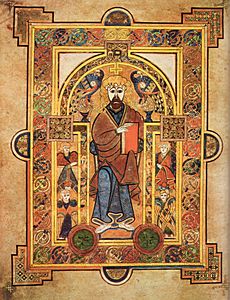
Before the Vikings arrived, the southern Hebrides were part of the Gaelic kingdom called Dál Riata. The northern Hebrides were supposedly under Pictish control. We don't know exactly when or how the Vikings took over the Isles, but we know that repeated Viking raids on the British Isles began in 793. Iona was attacked in 802 and 806.
In the 800s, people started talking about the Gallgáedil, meaning "foreign Gaels." This term was used for people who had a mix of Scandinavian and Celtic backgrounds or cultures. They became very important in southwest Scotland, parts of northern England, and the islands.
According to the Orkneyinga Saga, around 872, Harald Fairhair became king of a united Norway. Many of his enemies fled to the Scottish islands, including the Hebrides. Harald chased them and took over the Northern Isles in 875, and then the Hebrides a bit later. However, the local Viking leaders in the Hebrides rebelled. Harald sent Ketill Flatnose to deal with them. Ketill succeeded but then declared himself an independent "King of the Isles." He kept this title for the rest of his life.
The Powerful Uí Ímair Family
In 870, Dumbarton was attacked by Amlaíb Conung and Ímar, who were called "the two kings of the Northmen." They returned to Dublin with many captives. This shows that Scandinavian power was already strong on the western coasts of Scotland. Amlaíb Conung was called the "son of the king of Lochlainn," which was probably Viking Scotland and included the Isle of Man. This suggests an early start for an organized Kingdom of the Isles.
The early 900s are a bit unclear for the Hebrides. It's possible that Ragnall ua Ímair, who likely ruled the Isle of Man then, had some influence. The next King of the Isles we know about is Amlaíb Cuarán. He became King of Northumbria and probably also King of the Isle of Man. He was called the Rex plurimarum insularum, meaning "King of many islands," which suggests he might have been the first king of both the Isle of Man and the Western Isles of Scotland.
Amlaíb Cuarán died around 980 or 981. He was followed by Maccus mac Arailt and then his brother Gofraid mac Arailt. These two "sons of Harald" launched big attacks on Ireland. Gofraid is recorded as winning "the battle of Man" in 987. He died in 989 and was called "king of Innse Gall," which means "islands of the foreigners" and was a name for the Hebrides.
Earls of Orkney and Dublin Kings
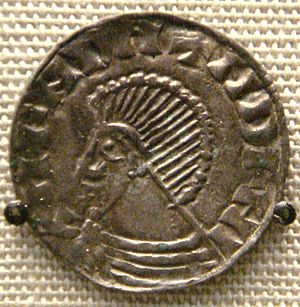
Around 990, Sigurd the Stout, the Earl of Orkney, took control of the Hebrides. He put a leader named Gilli in charge. By 1004, the islands were independent again under Ragnal mac Gofraid, who died that year. After Ragnal's death, Sigurd took control again until he died in the Battle of Clontarf.
Later, Olaf Sigtryggsson was recorded as king of many places, including the Isle of Man, other Danish islands, and parts of Scotland. He died in 1034. The next known ruler was Sigurd the Stout's son, Thorfinn the Mighty, who ruled from about 1035 for twenty years.
In the mid-1000s, Echmarcach mac Ragnaill was said to be the ruler of the Isle of Man. He was also King of Dublin, suggesting that the Isle of Man and the Hebrides might have been ruled separately again.
Later, Diarmait mac Maíl na mBó, the High King of Ireland, took control of the Isle of Man and the Isles until his death in 1072. Then, Godred Sitricson and his son Fingal Godredson ruled the Isle of Man.
Godred Crovan and Irish Power

Godred Crovan's name probably means "white hand." His background isn't fully clear, but he might have been related to a King of Dublin. He survived the Battle of Stamford Bridge in 1066 and fled to the Isle of Man. In 1079, he took the island from Fingal. Godred Crovan became the ancestor of many future rulers of the Isle of Man and the Isles. He also became King of Dublin. However, he was eventually forced out of Dublin and died on Islay in 1095.
There was a lot of political trouble around this time. A battle was fought on the Isle of Man in 1098 between the people from the north of the island and those from the south.
Later History of the Isles
Norwegian and Irish Influence
Perhaps because of the disorder in the islands, and to stop Irish influence, Magnus Barefoot of Norway took direct control again by 1098. He first took Orkney, the northern Scottish mainland, and the Hebrides. According to the Heimskringla saga, Magnus even had his longship dragged across the land north of Kintyre. By doing this, he could claim the entire Kintyre peninsula was an island, and it stayed under Norwegian rule for over ten years.
In 1098, Edgar of Scotland signed a treaty with Magnus. This treaty set the boundaries between Scottish and Norwegian claims in the islands. Edgar officially gave up his claims to the Hebrides and Kintyre.
In 1102, Magnus went on another expedition, attacking Ireland. The Heimskringla saga says he arranged for his young son, Sigurd, to marry the daughter of an Irish king. He then left Sigurd in charge of the Isles. But this didn't last long. On August 23, 1103, Magnus was killed in Ulster, and 14-year-old Sigurd went back to Norway without his bride.
The next king was Lagmann Godredsson, Godred Crovan's son. He ruled for seven years, then gave up his throne because he regretted blinding his brother. He went on a religious journey to Jerusalem, where he died.
After Lagmann, Domnall mac Taidc Ua Briain became the ruler of the Isles in 1111. He was not popular and was forced out by the Islesmen after two years.
Later, Olave Godredsson, also known as "the Red," became king. He ruled for forty years, bringing some peace and stability. However, in 1152, Olave's nephews attacked the Isle of Man and killed him.
Olave's son, Godred the Black, took over and had his father's killers executed. During his rule, the people of Dublin offered Godred control of their city, which he accepted.
The Rise of Somerled
Godred the Black's strict rule made him unpopular with the Islesmen. This led to conflicts that eventually broke up the Kingdom of Mann and the Isles. Powerful leaders in the islands started working with a new, strong figure: Somerled, the Lord of Argyll. Somerled had married Ragnhildis, who was Olave the Red's daughter and Godred's half-sister.
Somerled's popularity grew, and his son with Ragnhildis, Dubgall, was announced as a future King of the Isles (except for the Isle of Man). When Godred heard this, he fought Somerled's forces in a naval battle in 1156. There was no clear winner, but they agreed that Godred would keep control of the Isle of Man, the northern Inner Hebrides, and the Outer Hebrides. Somerled's young sons would control the southern Inner Hebrides, Kintyre, and the islands of the Clyde under their father's watch.
Two years later, Somerled invaded the Isle of Man, forcing Godred to flee to Norway. This made Somerled the undisputed ruler of the entire kingdom. Somerled effectively brought back the old kingdom of Dalriada. He is a very famous historical figure from the Scottish Highlands. His Norse name, Somarlidi, means "summer traveler," a common name for a Viking.
Somerled died in 1164, possibly killed during an invasion of mainland Scotland. After his death, Godred took back his old territories. The southern islands were divided among Somerled's sons as agreed: Dubgall got Mull, Coll, Tiree, and Jura; Islay and Kintyre went to Raghnall; and Bute went to Aonghas. Dubgall and Raghnall were even called "Kings of the Isles." However, their descendants didn't keep this title.
A Divided Kingdom and Its End
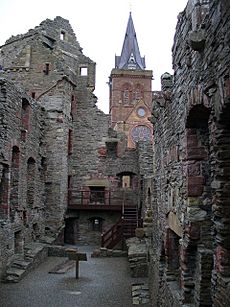
Somerled's descendants eventually became known as the Lords of the Isles. The family of Dubgall became Clan MacDougall, and Raghnall's family became Clan Donald and Clan Macruari. Aonghas and his three sons were killed on Skye in 1210.
In theory, Somerled's family ruled their islands under Norway, and their mainland areas under the Kingdom of Alba (Scotland). The Kings of Mann and the North Isles were also under Norway.
However, the Scottish kings wanted to control the islands held by Somerled and his family. When diplomacy didn't work, Alexander II led a large fleet in 1249. He died during this trip, but his son, Alexander III, continued the effort. This led to an invasion by Haakon Haakonarson, the King of Norway. After a battle that didn't have a clear winner, Haakon went back to Orkney, where he died in December 1263. After this failed expedition, the Hebrides and the Isle of Man were given to the Kingdom of Scotland in 1266, as part of the Treaty of Perth.
On the Isle of Man, Godred the Black took back his kingship after a brief challenge from his brother Ragnald. When Godred died in 1187, his oldest son, Raghnall mac Gofraidh, became king, even though Godred had chosen his half-brother, Olaf the Black, to succeed him. Olaf instead became the ruler of Lewis. In 1228, Olaf fought Raghnall and killed him. On May 21, 1237, Olaf died and was followed by his three sons, who each ruled the kingdom: Harald (1237–1248), Ragnvald (1249), and Magnus (1252–1265). Magnus Olafsson was the last Norse king to rule the Isle of Man before it became part of Scotland.
Life in Norse Times
We don't have a lot of archaeological evidence from this period, so we don't know much about the daily lives of the people. We do know that the Hebrides were taxed using a system called the Ounceland system. Evidence from Bornais suggests that settlers there might have been wealthier than people of similar status in the Northern Isles. This could be because the political rules were more relaxed. Later, the Hebrides sent representatives from Lewis, Harris, Skye, and the southern Hebrides to the Tynwald parliament on the Isle of Man.
Important Viking burial sites have been found on Colonsay and Oronsay. An 11th-century stone cross with Irish and Viking art was found on Islay in 1838. Rubha an Dùnain, a peninsula on Skye, has a small loch (lake) connected to the sea by an artificial canal. This loch was important for boats for many centuries, including during the Viking period. There's a stone quay and a system to keep water levels steady. Boat timbers found there date back to the 1100s. Only three rune stones (stones with Viking writing) have been found on the west coast of Scotland, on Christian memorials on Barra, Inchmarnock, and Iona.
Gaelic continued to be spoken in the southern Hebrides during the Norse settlement, but it seems to have been less important than Norse. Most of the old Gaelic place names were replaced by Norse ones.
Initially, the Norse culture was pagan. We don't have much detailed information about how Christianity returned to the islands during the Norse era. However, the modern-day Diocese of Sodor and Man still uses the old name, which comes from "Sudreys."
See also
- Duke of Argyll
- Kings of Jorvik
- List of Manx consorts
- List of rulers of the Kingdom of the Isles
- Lord of Mann
- Lords of Galloway
Images for kids



